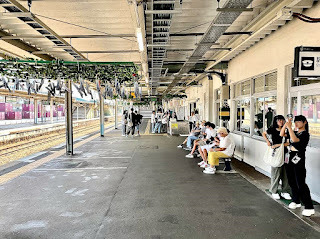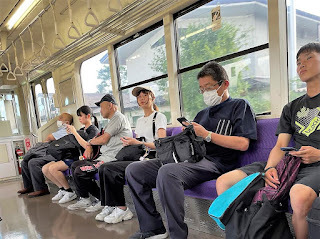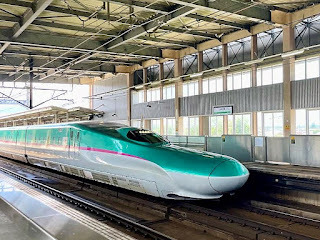On the trains: America has a lot to learn from abroad

The train sped through the ricepaddies that shone intense green in the bright sunshine. Some of the paddies seemedalready be turning yellow, somewhat early for the season in the beginning ofAugust. Behind the fields rose the Ōumountain range that separates the central valley of Iwate from the Sanrikucoast. It was a hot, clear day but thick white and black clouds were lingeringover the mountains. We were heading north towards the highest peak in therange: Mt. Iwate that reaches 2,038 meters above sea level and is the tallestmountain in the northern part of Japan’s main island, Honshu.
 This was a local train with just a fewcars, with seats arranged on the sides facing the center aisle, subway style.We could see the conductor standing behind the glass in his cabin at the frontof the train. Beyond him, we saw the tracks opening ahead of us. The train wasquite crowded on this Sunday afternoon. High school kids, boys in socceruniforms, old people dozing off, middle-aged women with shopping bags. Twopairs of young people were wearing beautiful cotton yukatas that looked cool inthe hot afternoon. I was the only gaijin – foreigner – on the train,which we had caught at the station in Mizusawa, my wife’s hometown, about 70kmsouth of the prefectural capital of Morioka. While we waited at the Mizusawastation, tens of nambu furin wind chimes provided a lovely soundtrack inthe light breeze. The Japanese Ministry of Environment has designated Mizusawastation as one of the 100 Soundscapes of Japan.
This was a local train with just a fewcars, with seats arranged on the sides facing the center aisle, subway style.We could see the conductor standing behind the glass in his cabin at the frontof the train. Beyond him, we saw the tracks opening ahead of us. The train wasquite crowded on this Sunday afternoon. High school kids, boys in socceruniforms, old people dozing off, middle-aged women with shopping bags. Twopairs of young people were wearing beautiful cotton yukatas that looked cool inthe hot afternoon. I was the only gaijin – foreigner – on the train,which we had caught at the station in Mizusawa, my wife’s hometown, about 70kmsouth of the prefectural capital of Morioka. While we waited at the Mizusawastation, tens of nambu furin wind chimes provided a lovely soundtrack inthe light breeze. The Japanese Ministry of Environment has designated Mizusawastation as one of the 100 Soundscapes of Japan.
The train ran smoothly, reaching highspeeds between the stops. The stops were rather frequent: not just the biggercenters of Kitakami and Hanamaki, but numerous smaller places: Kanegasaki,Rokuhara, and others. A few passengers were traveling with suitcases, headingto the Hanamaki regional airport, which in addition to domestic airports servesinternational destinations in Taiwan and Shanghai. Due to the frequent stops,the trip to Morioka took over an hour. We could have taken the shinkansenbullet train, which would have been much faster – the elevated shinkansentracks run more or less parallel to the local train tracks – but would thenhave missed the pleasure of slower travel at ground level. Traveling on theselocal trains in Japan is to me a distinct pleasure. It gives meaning to thetired old saying, attributed to Ralph Waldo Emerson: It’s not the destination.It’s the journey.
It is also such a joy to see thatthese local train lines are doing well and are in heavy use. They are carefullymaintained and widely used by a variety of people. Apart from the bullet trainand the local train line, there’s an superb highway – the Tohoku Expressway –that connects all these places. Yet, because of the excellent and affordablepublic transportation options, not that many people feel the need to jump intotheir own car. Consequently, the highway is not excessively crowded. Why botherdriving yourself when you can just jump on a train and enjoy the scenery?
Despite my love for the local trains,I do appreciate the shinkansen as well. The bullet trains are, well, fast,smooth, reliable, and environmentally sound. It impresses me that the ride isso even that you can leave your drink unattended on the tray while the speedapproaches or exceeds 300 km/h. The trains run so punctually that you canliterally check your watch based on when the train departs. There is not even halfa minute’s deviation from schedules (unlike in the US, where Amtrak staff only startthinking about getting the train ready a few minutes after the scheduled time).A couple of weeks ago we took the Yamabiko shinkansen from Tokyo to MizusawaEsashi,a trip of 500 km, which takes just over 2.5 hours.
 Last April, I had the pleasure oftaking the Nozomi shinkansen from Tokyo to Japan’s second city, Osaka, in thewest of the country. That trip runs just below Mt. Fuji, Japan’s tallest at 3,776meters. The iconic mountain boasts a perfectly symmetric cone rising close tothe sea at Suruga Bay. Admiring the handsome landscape as we sped by it, Iremembered years ago hiking to the top. It took several hours and, despite someadditional oxygen, gave me a splitting headache. However, staying overnight onthe summit was definitely worth it for the gorgeous sunrise over the PacificOcean. It’s easy to understand where Japan got its moniker as the Land of theRising Sun.
Last April, I had the pleasure oftaking the Nozomi shinkansen from Tokyo to Japan’s second city, Osaka, in thewest of the country. That trip runs just below Mt. Fuji, Japan’s tallest at 3,776meters. The iconic mountain boasts a perfectly symmetric cone rising close tothe sea at Suruga Bay. Admiring the handsome landscape as we sped by it, Iremembered years ago hiking to the top. It took several hours and, despite someadditional oxygen, gave me a splitting headache. However, staying overnight onthe summit was definitely worth it for the gorgeous sunrise over the PacificOcean. It’s easy to understand where Japan got its moniker as the Land of theRising Sun.
These types of train are not the onlyones in Japan. All major cities have functioning subways, and in many places –from Tokyo to Osaka to Naha in Okinawa – there are convenient and comfortablemonorails running on elevated tracks connecting the cities to their airports.All rails in the country are, naturally, electrified, another major differencewith the US. Of the Amtrak network, only the Northeast corridor, running fromWashington, DC, to Boston, passing through Baltimore, Philadelphia and New YorkCity, runs fully on electricity. The rest still relies on diesel and thuscontributes to pollution and climate change.
The US situation is globally theexception. Countries from Europe to China have clean and efficient high-speedtrains. As it happens, this year has allowed me to experience several of them.In May, I rode the Frecciarossa, which connects the north of Italy to thesouth, from Turin to Salerno. That train can reach even higher speeds, up to360 km/h. I only took it from Rome to Florence to see a friend there. In July,while in Finland, I rode the intercity train from Helsinki to the second cityof Tampere to visit another old friend. He had advised me to pay a few euroextra to reserve a seat on the second floor, which I did and could thus enjoythe scenery in quiet comfort (that is, until I descended to the restaurant carand joined a crowd of cheerful fellow travelers for a cold beer). The return toHelsinki was on an Italian-made Pendolino train, which is used in more than adozen countries across Europe, as well as in China and some routes in the US.
Continuing from my native country toSwitzerland, I landed in Zurich and had to travel to the capital, Bern, where Iwas to teach a three-day workshop hosted by the university. Naturally, I tookthe train. On the way back, there was an unfortunate delay due to an obstacleon the tracks, which forced the train to divert. The operators apologizedprofusely for the 6-minute delay in our arrival to Zurich.
This to me is the normal state ofaffairs. Virtually all developed countries have invested in high-speed electricrail networks. They are fast, safe, and environmentally sound. Only the US lagsbehind. Amtrak is losing money, with only the Northeast corridor operating on aprofit. The ticket prices are exorbitant, making the train trip from, say, thenational capital to New York City a luxury that is beyond the reach of manytravelers. While the Acela trains would be capable of traveling at high speed,the state of the old rails prevents it from doing so, thus rendering the trip muchslower than necessary – not to mention unreliable with frequent delays. As muchof freight in the US moves by rail, the freight trains get the right of way,forcing the passenger trains wait for their passing.
Lack of basic services, such as reservedseats, even in business class, makes the boarding process into a mad rush, adeficiency that could so easily be remedied. (I do have to admit that therehave been significant improvements to the boarding process at New York’s PennStation, which I could experience early in the year.)
In addition, there are occasionalderailments that give the perception that train travel is not safe. A recentpoll showed that a majority of Americans think that traveling by private car isthe safest mode of transportation, which obviously is far from truth,statistically. Still, derailments do happen and give Amtrak a bad rap. Recentones include a derailment in Missouri in June 2022 and in Montana in September2021, both of which resulted in loss of life. Add to that accidents, such asthe February 2023 Ohio tanker train derailment in East Palestine close to theborder to Pennsylvania, which spilled over 115,000 gallons of highly toxic andflammable vinyl chloride, it’s no wonder many Americans are suspicious of traintraffic.
California, arguably the mostprogressive state in the union, has worked on a high-speed rail link betweenLos Angeles and San Francisco since the $33 billion project was approved in2008. It was supposed to be completed in 2022, but is nowhere near there. Thecost overruns are staggering. The latest estimates have placed the real cost to$113 billion. According to the New York Times, the difficulties have beenmostly due to political compromises that have sent the tracks through variousdiversions through difficult, geologically complex, and costly routes in themountainous and earthquake-prone area. With the costs escalating and the heavydelays holding back progress, political and public support to the project isflagging.
There are many explanations and excuseswhy rail traffic doesn’t catch on in USA. The above-mentioned difficulties withefficiency, cost, safety, and perceptions certainly all are important. There isalso the issue of long distances. However, Europe is large, as well: it’s 3,300km from Stockholm to Madrid, for example, or about the same distance as fromChicago to San Francisco. Distances in China are also long: about 2,300 km fromShanghai on the coast to Kunming in the Southwest. Americans take flying as abasic human right. But with the mess the airline traffic finds itself –frequent delays and cancelations, onerous security checks, crowded planes, poorservice, unruly passengers – one would think that other alternatives wouldappeal to travelers. But for most people, the alternative that comes to mind isdriving, even if it takes hours and sometimes days on crowded highways withaggressive drivers. Supposedly, this reflects the deep rooted individualistic on-the-roadculture of Americans.
Then there’s the politics. In general,American politics from the Federal through State and local levels is highlycontentious and polarized, making it hard to pass any major legislationinvolving costly investment. The general position, especially on the right, isthat public investments – even as so much of infrastructure is crumbling – isunaffordable, as it would require raising the taxes for the rich. And, inparticular, public transport smacks of socialism. In this atmosphere, makingthe needed investments for improving – and electrifying – the rail networkwould not be an easy task. The good news is that the $1.2 trillion BipartisanInfrastructure Bill passed in 2021 does include $102 billion to improve railinfrastructure over the 2022-2026 fiscal years. It remains to be seen how farthis will reach. But you have to start somewhere.



